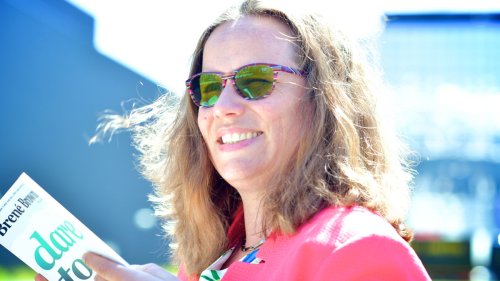Access for all
As ING’s head of global accessibility, Bianca Prins-Honkoop wants to make sure everyone can use our products and services. It’s all about being more inclusive. Bianca would know, she’s visually impaired herself. Here she tells her story in her own words.
Visual impairment runs in my family. I was born with cataracts and nystagmus (uncontrolled movement of the eye). I can only see 3% with my left eye, and on the right 85% for distance and 20-25% for reading.
Being born with a disability shapes your life: how you learn, think. I’ve grown to see solutions, not problems.
My mum loves to tell the story of how, as a toddler, when I started playing with my brothers, I used the walls to find my way around. Within a week I was able go everywhere my brothers could, even though I could hardly see. I had – stubbornly enough – learnt how to find my own way. Literally.
So it was probably back then that I started fighting for access to the world around me. Little did I know where it would take me.
Making a difference
By the age of 24, I was an independent lobbyist in the Netherlands, fighting for the rights of all people with a disability. I had found my calling.
As great as it was to stand up for a cause politically, I wanted to make more of a hands-on difference. My networking at the time brought me to ING where I joined the ‘Unknown Talent’ programme, as a person with a disability. Before long, I was pitching an accessibility plan to our chief information officer, Ron van Kemenade. Judging me on my capabilities rather than my disabilities, he asked me to drive the plan forward as head of global accessibility.
However, I can only work 20 hours a week. I have glaucoma from all my eye operations as a child. It tires me out and gives me terrible headaches. Reading towards the end of the day is a problem.
They had no problem with me working part-time, as long as I got the job done. How great is that! In exchange for their flexibility, they have someone who is totally committed to her role.
Time to wake up
That’s a good thing too, because there’s a real sense of urgency now to make our products and services more accessible. Part of that’s down to legislation on accessibility, which we are working to comply with. But more importantly, if we aren’t doing enough for people with disabilities, they’ll take their business elsewhere. We’re talking about 20% of the population. Who can afford to ignore that?
There’s still so much to do, but we’re making progress. We’ve added ‘read aloud’ buttons to articles on ing.com and we’re looking at adding a notch, braille and high-contrast colours to our debit and credit cards to make them more accessible.
Master plan
This brings me to our biggest step yet: the master plan to roll out one global accessibility strategy for ING customers and employees. The idea is to embed accessibility in the development of all new products and services, to think about people with a disability from the start. This is really all about being inclusive – in everything we do – for our customers but also for our employees.
Change is on the way, that’s for sure. Younger disabled people in particular want to take part in shaping the future. That’s why it’s so important for people like us to speak out; to be seen and heard. We are 20% of the world’s population, no one can afford to overlook us or underestimate what we can achieve when we put our mind to it. I’m proof of that.

